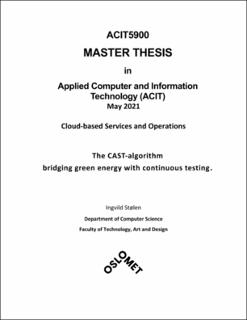The CAST-algorithm bridging green energy with continuous testing.
Abstract
In society today, we are dependent on software in our daily lives. One key factor of success
when creating this software is the use of automated testing. At the same time, we have a large
challenge in reducing greenhouse gas emissions to prevent global warming. Every day,
thousands of developers trigger automated tests, and each test uses some amount of energy.
The electricity used for running these tests can be produced in many ways, some of them
greener than others. Green energy often comes from intermittent renewable energy (IRE)
sources, such as wind and solar power plants. The intermittent nature of these power sources
means that they cannot supply one area with electricity throughout the whole day.
This project explores the possibility of moving software testing jobs in time and geolocation
(different data centers) to areas with green energy surplus, in order to minimize the
greenhouse gas emissions caused by the tests. The results showed that it is possible to reduce
the carbon footprint of automated tests by this method, but this requires sophisticated
infrastructure along with a geography where data about the supply and demand of electricity
and its production sources is available in sufficiently high resolution.
